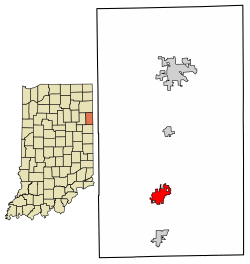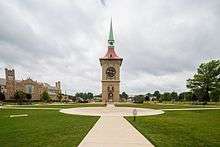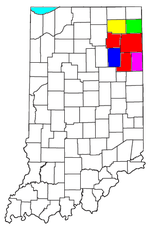Berne, Indiana
Berne is a city in Monroe and Wabash townships, Adams County, Indiana, United States, 35 mi (56 km) south of Fort Wayne. The population was 3,999 at the 2010 census. Berne and the surrounding area have become known for their large Amish population, who speaks Bernese German which is a Swiss German dialect.[6]
Berne, Indiana | |
|---|---|
 Clock tower in downtown Berne | |
| Nickname(s): Furniture Capital of Indiana | |
 Location of Berne in Adams County, Indiana. | |
| Coordinates: 40°39′29″N 84°57′15″W | |
| Country | United States |
| State | Indiana |
| County | Adams |
| Township | Monroe, Wabash |
| Founded | 1852 |
| Village plat recorded | 1872 |
| Incorporated (city) | 1887 |
| Government | |
| • Mayor | Gregg Sprunger (R) |
| Area | |
| • Total | 2.33 sq mi (6.03 km2) |
| • Land | 2.31 sq mi (5.99 km2) |
| • Water | 0.01 sq mi (0.04 km2) |
| Elevation | 843 ft (257 m) |
| Population | |
| • Total | 3,999 |
| • Estimate (2019)[4] | 4,247 |
| • Density | 1,836.14/sq mi (709.05/km2) |
| Time zone | UTC-5 (EST) |
| • Summer (DST) | UTC-4 (EDT) |
| ZIP codes | 46711, 46769 |
| Area code | 260 |
| FIPS code[2][5] | 18-04888 |
| GNIS ID[2][5] | 430849 |
| Website | www |
History
Berne was settled in 1852 by Mennonite immigrants who came directly from Switzerland, and named the community for the capital of Switzerland.[7] They began the chore of preparing for farming by clearing the land. However, farm markets were severely limited because of treacherous mud roads and distant trade centers. The advent of the railroad was soon to be the answer to the immigrant's prayers.
When the Grand Rapids and Indiana Railroad laid plans to construct a rail line through Adams County, two farmers, John Hilty and Abraham Lehman, offered a proposition: they would donate land to the railroad in exchange for the building of a rail depot in the small community. The deed indicates that Abraham Lehman and Christian Leichty were the parties who donated the land for the depot. The railroad companies agreed, and Hilty and Lehman (as recorded on the Original plat map of Berne on file at the Adams County, Indiana records office) quickly platted 10 building lots in anticipation of what was to come - more settlers. The lots were located in Wabash Township along an east to west road later named Main Street. On Christmas Day, 1871, the first train arrived at the local depot. This historical event marked the beginning of Berne, which was officially recorded as a community soon after. A post office was established in Berne in 1872.[8]
A steady stream of Swiss and German people came into the area from that train, as did English-speaking migrants, some of whom became successful businessmen in the new community. They contributed immensely in the growth of Berne. After the population of the town exceeded 2500, on a petition of 2/3 of the residents, the town decided to become a city in 1887. By 1895 the community was the second largest city in the county with an entrepreneurial business spirit and community activities revolving around many different church and social groups.[9][10]

Geography
Berne is located in northeastern Indiana at 40°39′29″N 84°57′15″W (40.658146, -84.954256).[11]
According to the 2010 census, Berne has a total area of 2.08 square miles (5.39 km2), all land.[12]
Demographics
| Historical population | |||
|---|---|---|---|
| Census | Pop. | %± | |
| 1890 | 544 | — | |
| 1900 | 1,037 | 90.6% | |
| 1910 | 1,316 | 26.9% | |
| 1920 | 1,537 | 16.8% | |
| 1930 | 1,883 | 22.5% | |
| 1940 | 2,075 | 10.2% | |
| 1950 | 2,277 | 9.7% | |
| 1960 | 2,644 | 16.1% | |
| 1970 | 2,988 | 13.0% | |
| 1980 | 3,300 | 10.4% | |
| 1990 | 3,559 | 7.8% | |
| 2000 | 4,150 | 16.6% | |
| 2010 | 3,999 | −3.6% | |
| Est. 2019 | 4,247 | [4] | 6.2% |
| U.S. Decennial Census[13] | |||
2010 census
As of the census[3] of 2010, there were 3,999 people, 1,620 households, and 1,078 families residing in the city. The population density was 1,922.6 inhabitants per square mile (742.3/km2). There were 1,797 housing units at an average density of 863.9 per square mile (333.6/km2). The racial makeup of the city was 96.5% White, 0.5% African American, 0.1% Native American, 0.6% Asian, 1.4% from other races, and 1.0% from two or more races. Hispanic or Latino of any race were 4.0% of the population.
There were 1,620 households, out of which 29.3% had children under the age of 18 living with them, 53.4% were married couples living together, 9.9% had a female householder with no husband present, 3.3% had a male householder with no wife present, and 33.5% were non-families. 31.3% of all households were made up of individuals, and 17.5% had someone living alone who was 65 years of age or older. The average household size was 2.35 and the average family size was 2.94.
The median age in the city was 42 years. 24.1% of residents were under the age of 18; 7% were between the ages of 18 and 24; 22.4% were from 25 to 44; 22.6% were from 45 to 64; and 24% were 65 years of age or older. The gender makeup of the city was 46.1% male and 53.9% female.
2000 census
As of the 2000 census,[14] there were 4,150 people, 1,639 households, and 1,104 families residing in the city. The population density was 2,307.3 people per square mile (890.2/km2). There were 1,690 housing units at an average density of 939.6 per square mile (362.5/km2). The racial makeup of the city was 97.64% White, 0.07% African American, 0.07% Native American, 0.22% Asian, 0.05% Pacific Islander, 1.04% from other races, and 0.92% from two or more races. Hispanic or Latino of any race were 1.90% of the population.
There were 1,639 households, out of which 32.0% had children under the age of 18 living with them, 57.5% were married couples living together, 7.7% had a female householder with no husband present, and 32.6% were non-families. 31.4% of all households were made up of individuals, and 18.9% had someone living alone who was 65 years of age or older. The average household size was 2.40 and the average family size was 3.02.
In the city, the population was spread out, with 25.7% under the age of 18, 6.8% from 18 to 24, 24.3% from 25 to 44, 19.3% from 45 to 64, and 23.8% who were 65 years of age or older. The median age was 40 years. For every 100 females, there were 86.5 males. For every 100 females age 18 and over, there were 80.5 males.
The median income for a household in the city was $35,491, and the median income for a family was $45,670. Males had a median income of $31,565 versus $21,563 for females. The per capita income for the city was $17,394. About 1.4% of families and 3.6% of the population were below the poverty line, including 2.5% of those under age 18 and 6.1% of those age 65 or over.
Infrastructure
Local Government
Mayor William F. (Bill) McKean has served as mayor since 2011 for the city of Berne. Mayor McKean served for 24 years on the Berne City Council before becoming mayor.
Along with an elected mayor, the city of Berne elects a Clerk-Treasurer and a city council. The council is composed of four members elected from the districts as established and one at-large member.
City parks
Clock Tower and Muensterberg Plaza
Constructed in 2010 the clock tower is modeled after the Zytglogge in Bern, Switzerland. Local enthusiasm for the project reached its peak during the summer of 2012 when the splash pad was first made operational in the center of the Plaza. As early as the summer of 2009, however, several residents were heard to publicly declare their admiration for and dedication to the Clock Tower, and soon after the Clock Tower Enthusiasts Club was formed.
The Plaza also features The Settler's Statue commemorating the arrival of the first settlers to the area, the only stateside Canton Tree, and a series of flowerbeds laid out to resemble common quilting patterns.
Lehman Park
Lehman Park is a wooded 11.5 acre park located at the intersection of US 27 & Park Ave. The land for the park was donated to the city by Isaac and Caroline Lehman. (The deed to the city is on file at the Adams County records office.)The park contains a sizable indoor pavilion with restrooms and electricity that can be rented year around of gathering and meetings. The park contains ample space for cookouts and reunions outdoors with provided picnic tables and grilling areas. The park contains two baseball diamonds primarily used on summer evenings by local baseball organizations but you are likely to see Amish families using the diamonds on Saturday and Sunday afternoons. (The Land for the baseball diamonds was donated to the city by Menno Lehman and Caroline Lehman, the son and the widow of Isaac Lehman. (Deed is on file at the Adams County, Indiana records office in Decatur, Indiana.) The park also contains two playground areas on the east and west side, a white sand volleyball court and an asphalt basketball court. The park has a concrete sidewalk around the perimeter allowing visitors to enjoy walking, jogging, biking or rollerblading. The approximate loop is 4/10ths of a mile. Adjacent to the park is the Berne Public Pool.
Utilities
Indiana Michigan Power (a unit of American Electric Power) provides electricity for Berne residents. The city of Berne provides water from its own wells, and also has its own water treatment facilities. Adams-Wells Internet provides internet services for Berne. Embarq (formerly Sprint) offers both voice and internet communications services. The cable company is Comcast. Comcast also offers phone and broadband services for its customers. Gas is serviced by NIPSCO, a NiSource utility company.
Library
The Berne Public Library, which opened its doors in 1935 and is currently located in the former city auditorium, serves the city of Berne. The library provides information services to all ages and holds over 60,000 titles, including print, digital, audio, and visual forms. The Heritage Room of the Berne Public Library contains local history and genealogical information.[15]
Notable people
- Army Spc. Nicholas (Nick) A. Taylor, 81st Troop Command, Indiana National Guard, killed in the line of duty serving during Operation Enduring Freedom on July 16, 2012 in Jannan, Wali Kot district, Afghanistan.[16]
- Mary Butcher (born 1927), All-American Girls Professional Baseball League player.[17]
- Bob Dro, who played baseball for the Brooklyn Dodgers and basketball on the Indianapolis Kautskys. From 1957 to 1976, he was an assistant athletic director at Indiana University.[18]
- Melissa Gillette, who held the world women indoor marathon record from February 26, 2012 until January 6, 2013.[19][20]
- Peter Luginbill, early founder and settler of Berne
- Donald Neuen, choral conductor[21]
- Keith Reinhard, Chairman Emeritus of DDB Worldwide.[22]
- Richard R. Schrock, awarded the 2005 Nobel Prize for Chemistry
- Dr. Ernie Steury, missionary doctor who established the Tenwek Hospital in Kenya.[23]
- The Dilley sextuplets, the USA's first surviving sextuplets.[24]
- Grant Moser (The Old Ball Coach), Current Head Football Coach for South Adams High School, Founder of Berne Basketball League, Former Berne Pool Manager, Coined the Phrase "I think I'll eat just one more."
References
- "2019 U.S. Gazetteer Files". United States Census Bureau. Retrieved July 16, 2020.
- "Feature ID 430849". Geographic Names Information System. United States Geological Survey. Retrieved June 30, 2014.
- "U.S. Census website". United States Census Bureau. Retrieved December 11, 2012.
- "Population and Housing Unit Estimates". United States Census Bureau. May 24, 2020. Retrieved May 27, 2020.
- "FIPS55 Data: Indiana". FIPS55 Data. United States Geological Survey. February 23, 2006. Archived from the original on June 18, 2006. Retrieved June 30, 2014.
- Meyers, Thomas J.; Nolt, Steven M. (2005). An Amish Patchwork: Indiana's Old Orders in the Modern World. Indiana University Press. p. 7. ISBN 0-253-34538-3.
- Merriam-Webster's Geographical Dictionary. Merriam-Webster. 1997. p. 138. ISBN 978-0-87779-546-9.
- "Adams County". Jim Forte Postal History. Retrieved August 26, 2014.
- Snow's History of Adams County. Author: J.F. Snow; Publisher: B.F. Bowen and Co., Indianapolis, 1907. Accessed April 2020.
- Bern, Berne, New Bern ... U.S.A.: A Short History of American Settlements with a Name Related to Berne, Switzerland. Author: Erdmann Schmocker; Publisher: Erdmann Schmocker, 1985. Length 236 pages. Accessed April 2020.
- "US Gazetteer files: 2010, 2000, and 1990". United States Census Bureau. February 12, 2011. Retrieved April 23, 2011.
- "G001 - Geographic Identifiers - 2010 Census Summary File 1". United States Census Bureau. Archived from the original on February 13, 2020. Retrieved July 28, 2015.
- "Census of Population and Housing". Census.gov. Retrieved June 4, 2015.
- "U.S. Census website". United States Census Bureau. Retrieved 2008-01-31.
- "Berne Public Library".
- "Military Times".
- All-American Girls Professional Baseball League Official Website. Retrieved on April 2, 2017.
- Dro, Robert C. (May 8, 2006). "Robert C. Dro". Berne Tri-Weekly.
- "Gillette Sets World Record". Berne Tri-Weekly News. Archived from the original on October 4, 2013. Retrieved February 29, 2012.
- "Nichole Porath Sets World Indoor Marathon Mark of 2:57". Runner's World. Retrieved February 1, 2013.
- "Local Artists to Perform at "Sounds of Switzerland" Concert". Times Bulletin (Van Wert, Ohio). Retrieved February 3, 2012.
- "Berne Clock Tower". THE DECATUR DAILY DEMOCRAT (Decatur, IN). Retrieved September 5, 2014.
- Lewis, Gregg (2007). Miracle at Tenwek. Grand Rapids, Michigan: Discovery House Publishers. pp. Back cover. ISBN 978-1-57293-222-7.
- Krull, John. "StarFiles: The Dilley Sextuplets". The Indianapolis Star. Retrieved February 29, 2012.
